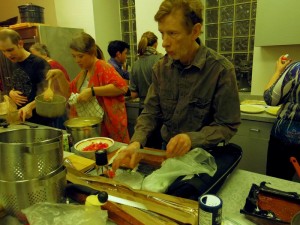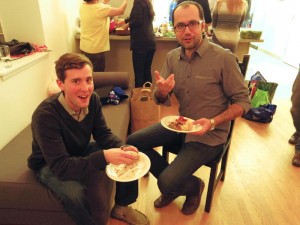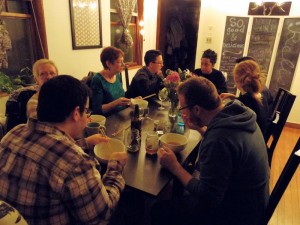By Kim Campbell (Kimchic)
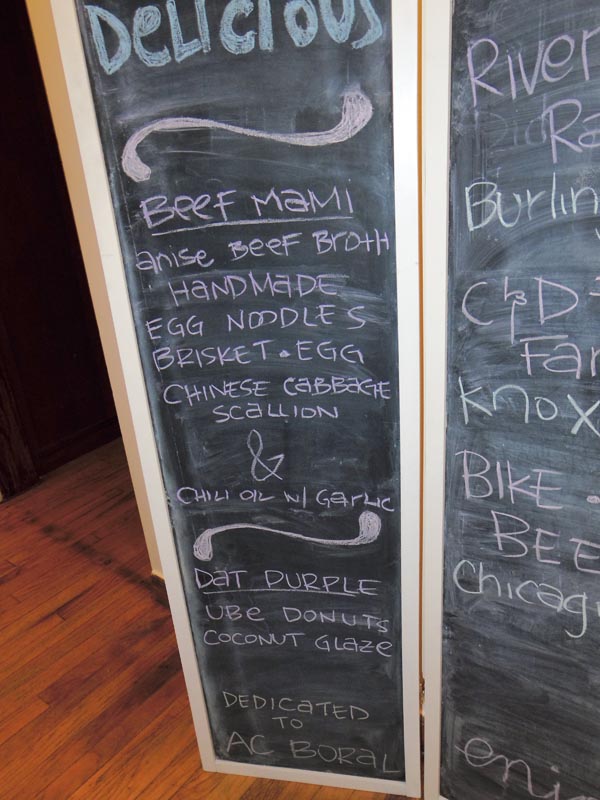
A handful of creative food venues, designed to throw us out of our comfort zone by highlighting the skill of enterprising new chefs, offering eclectic cuisines, or whisking up anticipation over a new restaurant, help make up the Chicago phenomenon that is alternative dining.
Pop-up restaurants, supper clubs, underground dining, and Chaos Cooking are among the out-of-the ordinary culinary experiences available to the adventurous Chicago diner. Some of these concepts have been around for decades; some are being reinvented by new chefs to fit modern tastes. They’re doing this by using social media to build hype, by incorporating contemporary concepts (such as using organic and locally-sourced produce), and by adding new twists to older concepts like the potluck.
For chefs who choose to showcase their skills through alternative dining venues, this is a way of breaking free from norms and courting innovation. It’s a mode of operation that reflects respect to everyone involved, lets chefs experiment with their craft, and – above all – builds community in ways that traditional dining can’t. The experience is mutually beneficial for chefs and diners, and adds variety to Chicago’s already-vibrant dining scene. Here is a sampling of the ways Chicagoans are creating and endorsing these delicious options.
Underground Dining with Relish
My first underground dining experience took place at Relish, on the third floor at a courtyard apartment complex. This dinner for eight was hosted by Chef Julia Pham; it featured cocktails and beer and Vietnamese cuisine in two courses. As with other underground venues, Relish is unofficial, emphasizing social interaction in a smaller, more intimate, less formal environment.
We started with a Filipino beef mami noodle dish – a heap of tender brisket in anise-flavored beef broth, served on egg noodles, Chinese cabbage, scallions, a slice of hard-boiled egg and a garnish of garlic chili oil. While we dined, guests for the second seating began to arrive and hobnob while they waited for us to get to dessert, which was a delicious parcel of ube (purple yam) donut holes with coconut glaze.
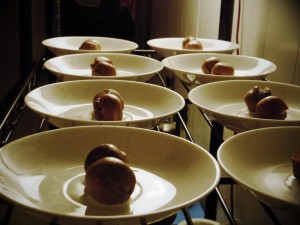
Julia Pham’s decision to start Relish came to her in a dream during a difficult period in her life. She saw herself serving delicious meals to old and new friends in her home and loving it. When she woke up, she knew that it was what she was meant to do. It took some research and preparation, but she already had years of experience working in her aunt’s Chicago-based bakery Ba Le and various kitchens during college. She decided to break away and do her own thing, with a nod to the Vietnamese cuisine she loved.
Pham said that she considers the act of alternative dining to be revolutionary. She explained why the scene is a good choice for chefs with a mission: “We maintain a structure that revolves around autonomy rather than hierarchy, and we feel empowered by practicing our abilities to create our own communities around food.”
Pham believes that food service does not need to be a strictly profit-driven structure and that all parties behind the food should be paid and treated fairly.
“There needs to be positive change in the food industry, where everything and everyone is respected, from the environment, to the farmers, to the ingredients, to the employees, and to the diners,” Pham said. She feels this would return food to its natural place in our lives, as part of a holistic cycle that sustains us through its production and consumption.
For Pham, then, Relish and other underground restaurants aren’t anti-establishment projects meant to skirt zoning and health laws. Rather, they are a way to express personal values while providing room to experiment, and be part of a DIY movement. She explained, “Many underground restaurants focus on locality and sustainability, which is something that is very important to diners who are looking to support conscious consumption. People also want to hear from small-name chefs who have different narratives and specialties than celebrity chefs in Chicago.”
For me, though, what was striking about Relish was the sense of community that I experienced that night. Everything, from the carefully-crafted menu to the warm and open environment, seemed designed to consciously break down the divide between guests and staff. We dined in the chef’s home, in an unhurried atmosphere that allowed intermingling between guests, server, hostess and chefs (when they weren’t cooking up the next round). No time was wasted on dish selection; no pressure was exerted to adhere to traditional restaurant etiquette. The usual barriers were gone, creating one of the main appeals of underground dining. In some ways, it was like any other party.
Experiencing the Chaos Cooking Movement
My next encounter with the alternative dining scene came as a result of a fortuitous meeting – at Relish, in fact. It turns out this isn’t an unusual way to get involved – once you’re in, you’ll meet others and learn of more options for alternative dining. Victoria DeMatteo was my source. In April she launched the Chicago version of Chaos Cooking, an interactive cooking platform, after attending events hosted by the movement’s founders, Brooklyn’s Joe and Margaret Che.
My impression of Chaos Cooking was that it would be a giant potluck party – with the caveat that all food had to be prepared at the event. Each participant was to bring a recipe to make on the spot, and everyone would enjoy the result. The one I attended took place in late April at the Test Kitchen in the Noble Square neighborhood, with 40 other amateur chefs.
Remembering to take the ingredients I needed was my first challenge, which I failed. Eking out a prep space was the second, and I was early. By the time I located my missing ingredient and returned, though, the “Chaos” part of the experience had kicked in. Imagine the din and clatter of a restaurant kitchen on a Friday night – except that everyone in the back wants to get their dishes finished so they can sample the offerings being laid out on long tables in the dining area. It felt like a race, a cooking contest and a speed-dating event combined.
The intrigue of this culinary adventure is easy to explain, DeMatteo told me. “The thing about Chaos is that it doesn’t require you to be a good cook. I don’t know of any restaurant that would hire a chef who can only make toast, for example! In the mainstream restaurant industry, the focus is on food quality and how good a dish tastes. In Chaos Cooking, people obviously strive for a delicious finished product, but it’s more about the social interaction and friendships that stem from the time spent with others.”
There was no toast served that night. A few of the foods that appeared while I was in attendance: spring asparagus with a wasabi hollandaise sauce, Thai chicken wings that vanished before anyone could grab seconds, curried roasted cauliflower and chickpea tacos with cabbage and avocado, breaded bacon, quinoa salad, asparagus pizza, pork dumplings, curried chicken salad on tiny slices of bread, and sticky mango rice.
In the midst of all the delicious dishes being turned out, it was clear that people were there to network as much as to eat. DeMatteo assisted this process by introducing people to one another and adding a bit of random fun by creating a cuisine-themed “Harlem Shake” video. I found Chaos cooking to be a great way to make friends with similar interests, and I got to know people through every step of the process. DeMatteo explained, “In our current age, there are so many ways of keeping tabs on everyone, yet outside of dating sites, there are very few ways to actually meet people. I think besides the fact that people are just seeking new friendships, more people also want to know where their food comes from and who is behind the dish they’re eating. The alternative dining scene offers both.”
Popping Up Everywhere
At this point, the idea of the pop-up is no longer new. Even the touristy Taste of Chicago features “pop-up” booths these days, proving that the definition of the word covers many things. But, whether in a home, food museum, business or hidden in the back of another restaurant (see Ampersand), pop-ups are still utilized as a marketing tool to create buzz for new restaurants or establish the name of a chef. And it’s a strategy that worked for an LTH Forum favorite, Fat Rice.
Fat Rice’s Abraham Conlon and Adrienne Lo started their Chicago culinary careers with a pop-up dining venture called X-marx in 2007. Abraham explained that his goal was always to provide the best food rather than an “alternative” to something else. He credits the experience of running a pop-up as his training ground for owning and operating a successful restaurant today. “It is a great forum for establishing a loyal client base and being able to experiment with food,” Conlon said, “but ultimately it is not sustainable because it is not lucrative enough. The doors weren’t always open so it was hard to employ people full-time.”
There were other challenges as well: “Quite frankly, it’s not strictly legal,” Conlon admitted. “After our second or third cease-and-desist order, we got that it was time to move on. It made sense, because X-marx became so popular that just two or three staff
Ultimately, Conlon feels the pop-up business was the place for him to experiment with food and to hone his business skills before moving on. He believes that the golden age of pop-ups and underground dining ended before he even began X-Marx, but he recognizes the importance it played in his success and agrees that it was an exciting time in his career.
He explained, “We did take what we learned from our experiences there, and have maintained the convivial atmosphere and the awesome food experience.”
The Tried and True – The Supper Club
Private supper clubs are deeply steeped in Midwestern tradition – and they’re well-established all over this area. But even these tried-and-true full-entertainment restaurant alternatives are becoming more modern, appealing to new folks with their dinner-party vibe and a more meaningful connection to both people and food.
Chef Micky Kearns, co-owner of the All Natural Chicago Catering Company (www.allnaturalchicago.com) and the Underground Supper Club (along with his wife Tess) is no stranger to unconventionality in the food world. Although his job is often to rein it in, Kearns says that liveliness is part of the appeal of alternative dining. “There is more of an air of circus at these events, and the customers are happier and more relaxed,” Kearns said.
He cites the need to feel special as a big motivation for diners. “Anyone can just go to a restaurant. No matter where or what a restaurant is, you can get a table, even if you have to wait a year. Underground supper clubs and pop-up restaurants are exclusive or temporary. This gives you the bragging rights of attendance. But people have more of an air of feeling privileged than one of entitlement,” Kearns said.
The Kearns’ goal is not simply to provide people with a good time, but also to connect them with their past in a meaningful way by providing seasonal and local food prepared in traditional ways. Kearns explained, “The last several years, there has been a drive of farm-to-table. The chef is the liaison that provides that. Slow food is bringing cooking back to the basics, the way our grandparents and parents did things.”
Regarding the use of local produce, Tess Kearns said, “It is always wonderful to present the new crops after a long winter. What you find in the store before spring came from far away. It usually lacks flavor or nutrient density because it is picked early to survive transport. The local stuff you get at the beginning of harvest is wonderful after a long winter like the one we just had!”
It turns out the farm-to-table way of looking at food is a factor for others in the alternative dining scene as well. Chefs Josh Kulp and Christine Cikowski, of Sunday Dinner Club (sundaydinnerclub.com) and Honey Butter Fried Chicken, keep themselves busy running two operations. But they say they find both important to their mission.
Josh Kulp explained how their hope is to help improve the industry with fair practices: “Restaurant work is very difficult. Christine and I make sure the company is respectful of staff. We aim to treat them as family. For example, we empower our sous chefs to make creative decisions, and we provide health insurance, paid time off, and sick days. Because many of our customers are faithful fans from Sunday Dinner Club, they usually cross over to eat at Honey Butter Chicken and they feel connected to our business. We prioritize keeping that connection with our sous chefs and clients because food has to nurture not just the customer at the table. It has to nurture the food producers and cook and servers.”
HOW TO DINE ALTERNATIVELY:
You might want to leave the electronic devices at home when you attend for that low-tech connection to people, but to attend a dinner club or pop-up restaurant night, you will need to get online to reserve your spot. Most events have a loyal following of enthusiasts and sell out fast. Visit a site like www.saltshaker.net/underground-dining-scene to figure out what your options are, and enjoy!
Like many in their field, Kulp and Cikowski place a high value on using local and seasonal ingredients whenever possible. They do this by going out of their way to establish relationships with farmers, farmers’ markets and community-supported agriculture like City Farm. They admit this can sometimes complicate things when they must adapt the menu to reflect what is available. “When that happens, I like to say we make decisions on a food by food basis,” Kulp explained. But the result is that the quality is so much better and the community connections reflect their overall mission of respecting the farm-to-table process of food.
Kulp and Cikowski began the Sunday Supper Club nine years ago, after they met at Kendall College Culinary School and had worked for a few years in restaurants. On their nights off, they started to invite friends over for a dinner party that became regular, and then expanded exponentially as word got out. Today their supper club has 5000 people on its guest list, and operates with a combination of catering, private chef permits, and shared kitchen licenses to remain above-board. As for Honey Butter Fried Chicken, its story is legend; the happy accident that occurred at Sunday Dinner Club when the chef spilled honey butter on a dish of fried chicken one night is well documented. Rather than serve the sticky sauce-covered chicken, the folks in the kitchen decided to eat the chicken themselves — and one bite told them they’d invented something special.
Here’s where the advantage of having a supper club atmosphere kicks in: at a traditional restaurant, Cikowski said, she’d never have run out of the kitchen to tell her guests to pour honey butter on their chicken. But here, she felt quite at ease doing it – and the result became not just a staple dish, but a separate business.
“I started cooking because I loved it,” Kulp said. “I was always interested in food, but the best part is when I finish the cooking and watch the person eat it. I need someone besides myself to take a bite of it. Working in a restaurant was tough because there was a disconnect between me as a chef and the people in the dining room eating the food. We wanted Sunday Dinner Club to feel more like being with grandma over a pot of ragout rather than a fancy meal out.”
His supper club might be a low-tech experience, but that’s part of the appeal. “People put away their cell phones and enjoy live company and a meal made from scratch,” he said. “More and more these days, people are seeking out ways of connecting as the prevalence of family meals decline in our lives.”
Building Community Through Alternative Dining
Clearly, there’s no one reason that chefs and owners choose the alternative dining route. Quality and the freedom to experiment is important – these innovators get to think outside the box, toward ideas and concepts that aren’t necessarily welcome within the structure of the regular dining establishment – and they feel like revolutionaries when they get back to basics and let their personal values have more priority. But there are two things most of these operations have in common: their desire to build connections – to establish a loyal customer base, to get people together, to network, and to create relationships – and their desire to make great food.
Just like the chefs, diners have multiple reasons for embracing the alternative dining scene in Chicago. As with a standard restaurant outing, they get a night out and a table full of delicious food, but they also enjoy the added seasoning of mystery – and sometimes, a sense of returning to their food roots or being among the first to experience a trend in the dining scene. But the fact is, most diners go out to eat because they’re looking for good food and good company. Alternative dining is just another way for diners to get the best of both worlds.
So, both owners and diners, alternative dining hearkens back to two very basic human needs: that of being together and eating well. In the words of Chef Micky Kearns of the Underground Supper Club: “Ultimately, people come for the food, but they also come to experience the social aspect of community tables and interaction with fellow foodies. Discovering these special opportunities creates an atmosphere of [being] comrades-in-arms.”


